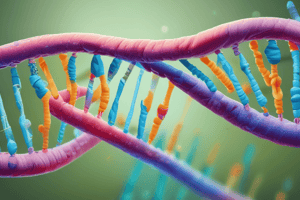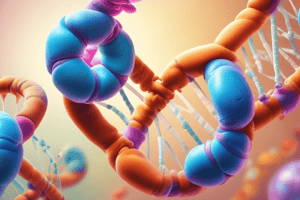Podcast
Questions and Answers
Which molecule carries the genetic code of life?
Which molecule carries the genetic code of life?
- RNA
- ATP
- DNA (correct)
- Protein
What forms a rung in the ladder-like structure of DNA?
What forms a rung in the ladder-like structure of DNA?
- Nucleotide bases (correct)
- Glycogen
- Amino Acids
- Lipids
What are the purine bases that always bind to pyrimidine bases in DNA?
What are the purine bases that always bind to pyrimidine bases in DNA?
- Adenine and Guanine (correct)
- Adenine and Cytosine
- Cytosine and Thymine
- Guanine and Thymine
What is the complete set of genetic material carried by an organism called?
What is the complete set of genetic material carried by an organism called?
How many genes are estimated to be in the human genome?
How many genes are estimated to be in the human genome?
Which molecule is responsible for decoding genes and synthesizing proteins?
Which molecule is responsible for decoding genes and synthesizing proteins?
What is the term for the process where a segment of DNA is copied into messenger RNA (mRNA)?
What is the term for the process where a segment of DNA is copied into messenger RNA (mRNA)?
Which type of modifications are involved in regulating gene expression without changing the DNA sequence?
Which type of modifications are involved in regulating gene expression without changing the DNA sequence?
What are examples of epigenetic modifications mentioned in the text?
What are examples of epigenetic modifications mentioned in the text?
Which technology has simplified genome editing and opened doors to novel therapies for genetic disorders?
Which technology has simplified genome editing and opened doors to novel therapies for genetic disorders?
What role do environmental factors, chemical signals, and thoughts play in influencing gene expression?
What role do environmental factors, chemical signals, and thoughts play in influencing gene expression?
What does epigenomics refer to in the context of genetic regulation?
What does epigenomics refer to in the context of genetic regulation?
Study Notes
Genetics: Exploring Life's Building Blocks
Genetics, the branch of biology dealing with hereditary traits and genetic variation, plays a fundamental role in our understanding of life itself. From the molecules that store genetic instructions in cells to the processes that transmit these instructions across generations, genetics is a vast and intriguing field. Let's delve into the fascinating world of genetics through key concepts, recent discoveries, and future prospects.
The Double Helix: The Language of Life
At the heart of genetics lies DNA (deoxyribonucleic acid), the molecule that carries the code of life. Its discovery revolutionized biology, providing a physical basis for inheritance and explaining how organisms pass traits down through generations. DNA consists of nucleotide bases paired together in a double helix structure, forming the familiar ladder-like design. Each base pair forms a rung in the ladder, where the purine bases (adenine and guanine) always bind to the pyrimidine bases (cytosine and thymine).
Genome: The Instruction Manual for Life
The complete set of genetic material carried by an organism, known as the genome, contains all the necessary information for growth, development, functioning, repair, and reproduction. The human genome, for instance, holds around 20,000 genes, which serve as blueprints for proteins and control various aspects of our physiology.
Gene Expression: Decoding the Code
Not all genes are active all the time. Only those needed for a given stage of life or specific conditions become expressed, producing functional products called proteins or RNA. This regulation happens via transcription, where a segment of DNA is copied into messenger RNA (mRNA), and translation, where mRNA codes for protein synthesis. Environmental factors, chemical signals, and even our thoughts can influence gene expression.
Epigenomics: The Extra Layer of Control
Beyond the genetic code itself, epigenetic modifications are involved in regulating when, where, and how our genes work. These alterations affect how the DNA interacts with regulatory proteins without changing the underlying sequence of nucleotides. Examples include DNA methylation and histone modification, both of which play roles in determining whether a region of the genome is turned off or on.
Recent Advances and Future Possibilities
Technologies like CRISPR/Cas9 have made editing the genome much simpler, opening doors to novel therapies for inherited diseases or genetic disorders. Additionally, advances in single-cell genomics allow researchers to analyze individual cells, revealing previously hidden complexity within tissues and populations. As we uncover more about the genomic landscape, the potential applications expand, including personalized medicine tailored to individuals' genetic makeup.
In summary, genetics is an ever-evolving field that continues to reveal remarkable insights into the inner workings of life. By exploring these building blocks further, scientists hope to deepen our understanding of health, disease, and even the origin and future of humanity.
Studying That Suits You
Use AI to generate personalized quizzes and flashcards to suit your learning preferences.
Description
Explore the captivating world of genetics, from the discovery of DNA to the intricate processes of gene expression and epigenomics. Learn about the genome as the instruction manual for life and delve into recent advances like CRISPR/Cas9 technology and single-cell genomics. Genetics holds the key to understanding health, disease, and the essence of humanity.




